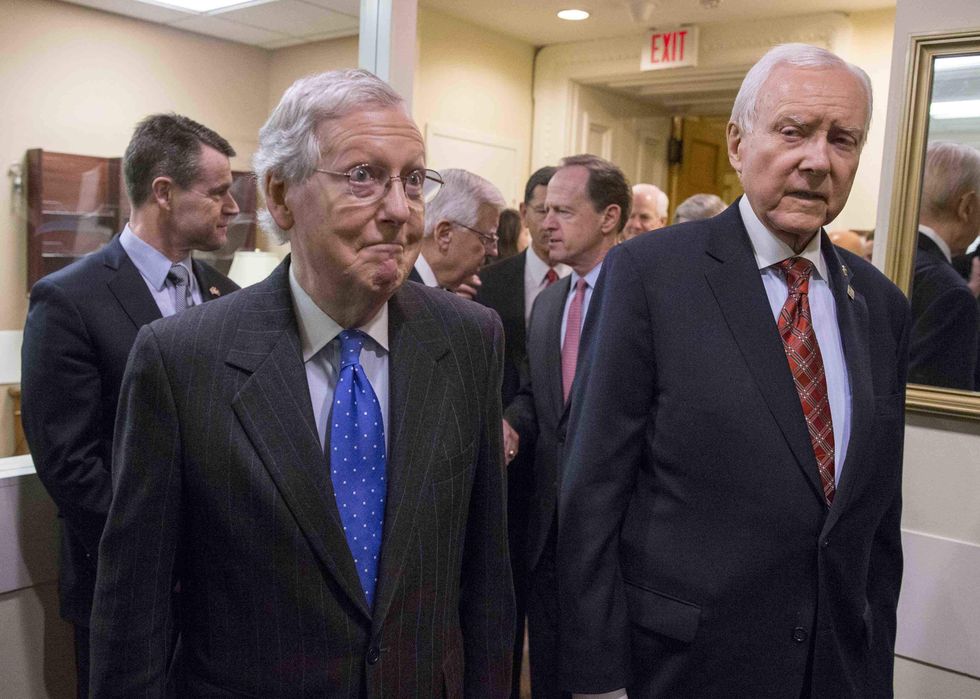After years of promising tax relief to the American people, Republicans have finally delivered. The Tax Cuts and Jobs Act, which President Donald Trump will soon sign into law, lowers tax rates for individuals and couples, cuts taxes for businesses, and provides significant aid to lower- and middle-income families. This legislation represents the largest tax cut in modern history, and as such, has received a lot of criticism — some fair, some very unfair.
Because of the significant attention the legislation has received and the notable changes it has undergone throughout the legislative process, a lot of false information has circulated about the tax reform bill. Here are five of the most important things you need to know about the Tax Cuts and Jobs Act, all of which are based on facts, not propaganda from the left or the right.
No. 1: It’s not focused on helping ‘the rich.’
Perhaps the greatest distortion of the legislation is that it’s only going to help wealthier Americans. Many of the bill’s critics say that because most of the biggest cuts are for corporations and small businesses, it will end up fattening the pockets of rich people and eventually resulting in spending cuts for government programs used by the poor.
The Tax Cuts and Jobs Act does reduce business taxes. The corporate tax rate will be slashed from 35 percent to 21 percent, and small business owners, many of whom now pay a 39.6 percent tax rate on their pass-through income, will pay a lower rate and be able to deduct 20 percent of their income earned from their business.
While these may sound like provisions designed to help the wealthy, they actually benefit lower- and middle-income people in a number of ways. First, if businesses have more money to spend, free-market advocates believe businesses will expand and hire more employees. Those new employees will spend more money, benefitting the entire economy. Further, as the economy continues to improve, businesses will be forced to compete with one another for high-quality employees, driving up wages for everyone.
Second, many corporations have been moving overseas over the past few decades because America’s tax code has been much more punitive compared to tax codes in Europe and in other parts of the developed world. By cutting the corporate tax rate, businesses are much more likely to stay in America, keeping middle-class jobs from being shifted overseas.
Third, many corporations are publicly traded on the stock market. If you own stock, that means you are a part-owner of the company you have stock in. You benefit from the tax cuts for corporations because corporate profits will rise, making the company more valuable and thus your stock more valuable. As Stephen Moore, a senior fellow at The Heritage Foundation, noted recently for The Washington Times, there are about 55 million Americans with 401(k) plans, 20 million have IRAs, and 20 million more have pensions. All of these people will benefit in one form or another from lower corporate tax rates.
No. 2: The legislation is focused on lower- and middle-income families.
Even left-leaning think tanks acknowledge that more than 80 percent of filers will receive a tax cut under the Tax Cuts and Jobs Act, but some will benefit a lot more than others. If you’re a lower- or middle-income earner with children, you’re very likely to be among those who will benefit the most.
The tax reform legislation doubles the tax credit people with dependent children can claim for every child, from $1,000 to $2,000. It’s important to emphasize that this is a tax credit, not a tax deduction. Deductions lower the amount of your income you are required to pay taxes on, but tax credits are much more valuable; they apply directly to your tax bill. So, if you calculate your taxes without applying the child credit and you owe $10,000 in federal income taxes, the tax credit will lower your bill by $2,000 per child. For this reason, all lower-income households with multiple dependent kids and the vast majority of middle-income households with multiple kids will pay nothing or almost nothing in federal income taxes.
Additionally, because the tax credit is refundable, families with lower incomes and middle-income families with lots of kids will get a significantly larger tax refund (up to $1,400 per child).
No. 3: The tax cuts will increase the debt, but not by as much as you think.
Many in the mainstream media and in the Democratic Party continue to claim the Tax Cuts and Jobs Act will cost close to $1.5 trillion over a decade. This figure is almost certainly wildly incorrect. The $1.5 trillion number assumes there will be no additional economic growth created by the tax cuts and that the Republican-led Congress won’t cut other spending programs.
The Tax Foundation reports that when expected economic growth and expansion are included into its economic projections, the cost of the tax cuts will actually be much closer to $448 billion over a decade, or about $44.8 billion per year. The Trump administration has stated it believes the legislation will cause so much economic growth, it will end up being revenue neutral.
Even if we assume the Trump administration is wrong and the Tax Foundation’s estimates are closer to reality, it wouldn’t take much to slash $44.8 billion in wasteful spending from the multitrillion-dollar budget. Citizens Against Government Waste (CAGW) identified in its 2017 analysis 607 recommendations that would save taxpayers $336.2 billion in the first year.
No. 4: The bill does very little to simplify the tax code.
One of the biggest selling points of tax reform has been that the tax code is far too complex and needs to be simplified. Republicans have long promised to create a new, flatter, simpler tax code, and in the early stages of the Tax Cuts and Jobs Act, it appeared things were moving in the right direction. The version of the bill the House of Representatives originally passed had fewer brackets, and most people would be able to fill out their taxes on a simplistic, relatively small form.
However, once the Senate began crafting its legislation, the simplicity of the House bill ended up getting tossed aside. Moderate senators demanded more deductions remain in place, and Senate rules limiting how much the tax bill could cost led the Senate to keep all seven tax brackets. These two developments doomed any hope of a simpler tax code.
There is some good news for filers. The Tax Cuts and Jobs Act does eliminate a number of deductions and doubles the standard deduction to $12,000 for individuals and $24,000 for couples. It also ends the current “exemption” system. Because it only makes sense to itemize deductions when you have enough deductions to surpass the value of the standard deduction (you can’t claim both the standard deduction and itemized deductions), doubling the standard deduction means fewer people, especially middle-income people, will need to worry about itemized deductions at all, greatly simplifying the process.
No. 5: The bill isn’t perfect, but you shouldn’t blame conservative Republicans.
Despite its many benefits, the tax reform legislation is far from perfect. Many of its key cuts (other than the business cuts) will expire over the next decade. Further, a “Fair Tax” system, which would have replaced income taxes with a sales tax system, or a flat tax model would have been much better and more in line with conservative-libertarian thought.
Additionally, many of the deductions, credits, and other complexities of the tax code, including a modified version of the truly horrific Alternative Minimum Tax, will remain in place.
It’s also worth noting there are all kinds of little special projects and provisions jammed into the bill that arguably have no business being there or aren’t getting much attention. In October, Sen. Bob Corker (R-Tenn.) said the provisions are meant for “buying off people” and are “ridiculous.” It’s unclear just how many of these are in the bill’s final version, but as time goes on, it’s likely we’ll find out about all sorts of unsavory provisions thrown into the legislation at the last minute to win over one or two wavering senators.
In a perfect world, this bill would be very different, but this isn’t a perfect world. Most of the things conservatives would have liked to see in this legislation weren’t politically feasible or couldn’t be included in the bill because of foolish Senate rules, which greatly limit what can be passed using the budget reconciliation process. Had Democrats been willing to vote to end debate on the legislation, allowing the Republicans to pass a bill through the normal legislative process, and had moderate Republicans, especially in the Senate, been more willing to do away with some largely unnecessary deductions, the Tax Cuts and Jobs Act would have been much better.
Even with these flaws, though, it’s a remarkable achievement that will lower taxes for most people and create immense economic growth. This is a major win for congressional leadership, President Donald Trump and the American people.
Justin Haskins (Jhaskins@heartland.org) is executive editor and a research fellow at The Heartland Institute.



